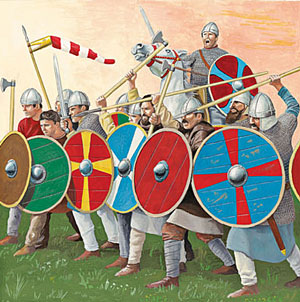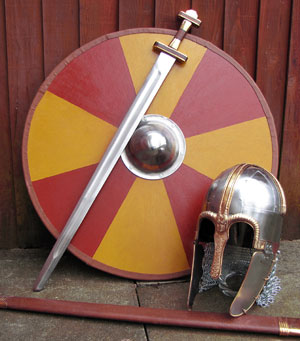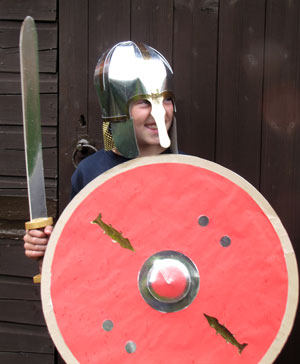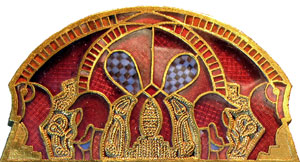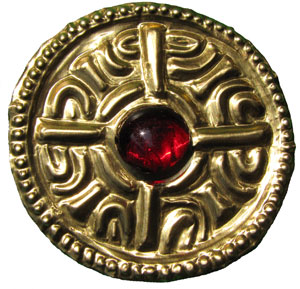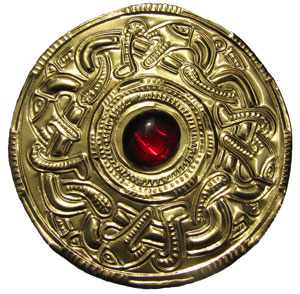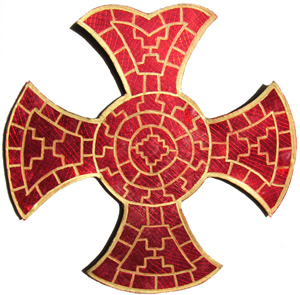| Home | Fossils & Bones | Evolution | Pharaohs | Egyptian Fashion | Pyramids |
|
Greek Warfare | Romans in Britain | Anglo-Saxons |
|
A new workshop on Anglo-Saxon Warfare and Jewellery |
The Kingston Brooch - perhaps the finest example of Anglo-Saxon jewellery, now in the Liverpool Museum (also the background to this page). |
|
|
This workshop is designed to cover the Anglo-Saxons unit of the KS2 National Curriculum for History. It is suitable for year 5 or 6*. Main Activities: 1. Learn about Anglo-Saxon weapons and armour 2. Make shields and helmets 3. Learn about Anglo-Saxon gold and silver jewellery 4. Make jewellery Fee: £239 per class for the whole day. Maximum 32 children/class. To book: contact Tony North tnorth67@hotmail.com 0161 224 6445 *Note: the art activities are challenging and are only suitable for classes with good art and crafts abilities. The lesson is also suitable for very able year 4s, with good skills in listening and following instructions. For all classes extra adult assistance will be needed to ensure good outcomes. Feedback from teachers and children 'The children thoroughly enjoyed the hands on workshop and were able to produce some fantastic artwork.'
Decoration on the end of the Sutton Hoo sword |
Introduction After the collapse of the Roman Empire in the 5th century the peoples of northern Europe - Angles, Saxons and Jutes - quickly moved to fill the power void left in Britain, settling, taking control, and introducing their culture to the Britons. 1500 years later we still owe a great deal to these peoples, in our language, culture, and genetic inheritance. This workshop takes a look at two essential aspects of Anglo-Saxon life - weapons and warfare, and jewellery. The many stunning works in gold and silver left by the craftsmiths reveal that this period is unfairly known as a Dark Age.
Children will learn about the legacy of the Anglo-Saxons and create two works of art - a helmet or shield, and a piece of gold or silver jewellery. The materials and methods are very high quality and you will be impressed with the results. We will also look at replicas of a sword, shield and helmet in the morning, and replicas of jewellery in the afternoon. Children also get to write their names in runes and try rune puzzles. Photos of Workshops: Brandwood Primary, Bolton, Apr 15 - just jewellery St Richard's Atherton, Jan 15 - just warfare Sutton Oaks, St Helens, Jan 15 - just warfare St. Aidan's, Manchester, Feb 15 (display made by the teacher of the armour and children's writing) Note: the sword is no longer made in this workshop |
|
|
Lesson Plan |
||
|
Morning Session: Warfare I will set out materials for the warfare craft activity before the lesson starts. I will need some children to help. 1. Introduction to the Anglo-Saxons (15 mins) Who were the Anglo-Saxons? Where did they come from and why? What changes did they bring to Britain and its people? (look at photos, maps, artistic reconstructions etc. on the whiteboard) 2. Anglo-Saxon Warfare (15 mins) A look at Anglo-Saxon warriors and their gear. Children will see my replicas of a sword, helmet and shield: Click photo for a larger version.
My replica of the Coppergate helmet
The real Coppergate Helmet, in the Yorkshire Museum in York. Mostly iron, it has now rusted. It was owned by a nobleman, and has two gold bands inscribed with a Christian prayer, and his name, Oshere.
Click here to see the inscription and its translation
3. Make helmets and shields (100-120 mins) Children will work in pairs to make Anglo-Saxon helmets and shields. They use a wide variety of high quality materials such as strong card, gold and silver metallic card, strong glue, and sellotape. The finished items look amazing and make a wonderful display (see photos right for examples). As the helmets are difficult and time consuming a maximum of 6 pairs will make them.
Lunch Break I will need some children or adults to help me set out the materials for the jewellery making in the afternoon.
Making a helmet at Sutton Oaks Primary
The shield found at Sutton Hoo (early 7th century burial of a king)
The famous Sutton Hoo helmet, in the British Museum
The bird decoration on the Sutton Hoo shield
|
Helmet: Replica of the Coppergate helmet which children will make. The helmet is made with gold and silver card, templates, and rubber grip mat material painted gold, to give a chainmail effect.
Shield:
Shields were usually round with a conical boss. Little is known about the designs although metal decorations have been found and traces of colours painted on the front.
Children can choose from various designs. The rim was bound with leather; in the workshop brown wrapping paper is used.
Click photo to see larger version
Close-up of the shield boss. They usually had a 'button' on the top.
A real shield boss
If any children finish they can do a rune worksheet. They can write their name in runes, then put them on their helmet or shield.
Side view of a reconstruction of the Sutton Hoo helmet
Two Anglo-Saxon swords: the Sutton Hoo sword (British Museum) and the Gilling Sword (Yorkshire Museum)
|
Afternoon Session: Jewellery 1. Introduction to Anglo-Saxon Art and Jewellery (30 mins) Children learn about Anglo-Saxon metalwork such as brooches and clasps. Like the weapons and armour seen in the morning, these items were beautifully decorated. Given the impressive artistry of Anglo-Saxon jewellery, one might ask whether this period should really be called the Dark Ages.
Can you see two boars, as well as two birds? We will look at photos (see examples below) as well as some replicas of gold and silver jewellery (made in the same way that the children will make their own copies). These items often have features such as animals (e.g. snakes and birds) hidden in the intricate details of the artwork. These can be fun to try to find and we will play a game of 'spot the animal' (see Sutton Hoo clasp above).
One of the items children will make 2. Making Jewellery (90+ mins) Children now make their own jewellery. They use special gold and silver foil for embossing, as well as carefully designed paper templates, red glass pebbles and red sticky back vinyl (to represent the garnet stones inlaid in brooches), embossing tools, gold and black permanent marker pens, and ballpoint pens. The foil is tricky to work with and easily damaged, so lower ability children will use high quality gold card instead of the foil (as well as red vinyl and gold pens). All children can stick a safety pin to the back of the brooch so it can be worn, or displayed on a piece of cloth (an adult will be required to attach the pins).
The photos above and below give an idea of what these items will look like. There are 14 designs, to suit a range of abilities. Children work on their own except for 2 very complicated designs (if these children finish they can make another one). Click here to see large photos of the replicas plus the originals.
Centre of the Fuller Brooch
One of the decorations on the outside of the Fuller Brooch (there are 4 to choose from)
Support needed This activity is challenging, but intensive teaching and support will be given. To ensure good outcomes, however, it will be necessary to get extra adults in to help (TAs or parents) - both for this and the warfare session. The photos below show some of the original jewels.
The Fuller Brooch (British Museum) (11.4cm)
Brooches were usually made with gold, silver, garnet, niello, glass, and shell.
The Ixworth Cross: a 7th century jewel made from gold, glass and garnet. Shown actual size (5cm). This is one of the easier items for children to copy in the morning. The copy children make is 10cm and made from gold card, red vinyl and gold Sharpie pen (see below).
|
|
Click here to see more photos of the jewellery |
||

